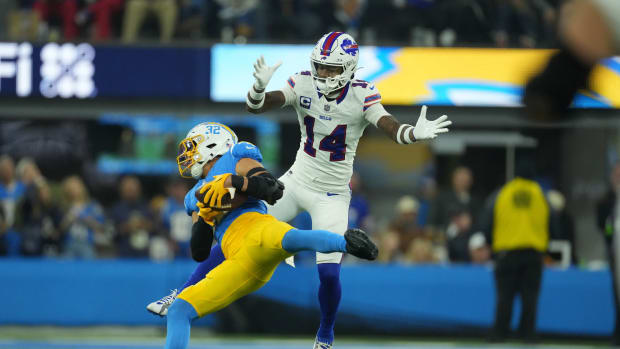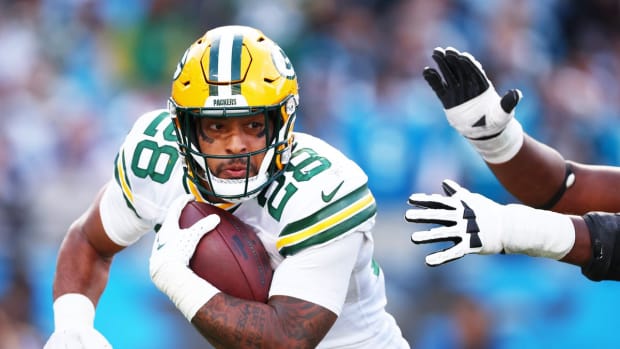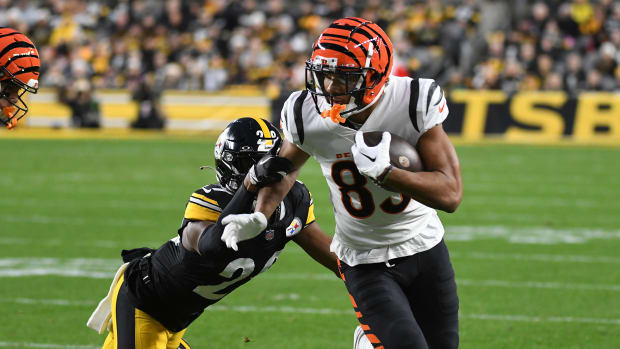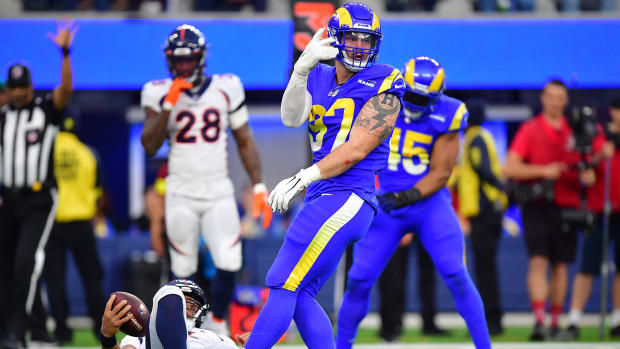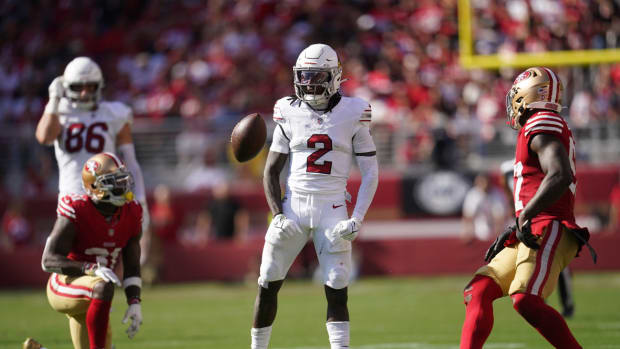The NFL All-Over-30 Team
A few notes about this All-Over-30 Team:
• It consists of players who were 30 or older as of June 1.
• The pool of eligible players was small. Not counting special teamers, there are, on average, about seven players per team over 30 years old, which makes for 225 players leaguewide, and about 90 of them warranted consideration for this team. The point: the NFL players who make it into their 30s tend to be the really, really GOOD players—which seems obvious now that we’ve stopped to consider it. It is easier to find a star over 30 than a role player over 30.
• The clock is ticking on most of these non-quarterback players. There were copious great players to choose from on the All-Over-30-Team, but an All-Over-32-Team would have been very hard to put together. The data suggests players decline rapidly in their early 30s.
• Lastly, this team, like all of the other teams in this series of stories, was selected with the idea of constructing the best overall roster. Usually, that means simply picking the best players. But once in a while, it means picking the players whose styles best complement one another, which is how actual NFL rosters are built.
Starters listed in bold.
Quarterback
Tom Brady, Patriots—41 years, 10 months
Drew Brees, Saints—40 years, four months
It’s easier than ever for “old men” to play quarterback—the rules shield them from most of the really dangerous hits and so many offenses are built on quick throws, which require less arm but a higher presnap IQ (favoring experience). Brees is the perfect example. Brady, on the other hand, is simply a football god. Physically, he’s about as sharp now as he was 10 years ago. And mentally, he’s obviously even better. Overall, there’s a strong argument that Brady at almost 42 is better than he was at 32.
Running Back
Adrian Peterson, Redskins—34 years, two months
LeSean McCoy, Bills—30 years, ten months
FB James Develin, Patriots—30 years, ten months
Besides Doug Martin, Peterson, McCoy and Frank Gore were the only tailbacks worth considering for this team; every other quality back is in his 20s. Peterson is still outstanding in terms of short-area burst, one-cut lateral movement and power; what he has lost is top-end speed. McCoy, who struggled last season (though often due to Buffalo’s pitiful offensive line putting him in a bind) will be an interesting case study in 2019. His game is built on lateral agility and balance, and they say when a running back hits a wall—which, as this exercise has proven, is indeed by age 30, if not sooner—balance is the first thing to go. For our team, that’s a problem, since McCoy is our only true backfield receiving threat. Develin is here because with no quality blocking tight ends available (see two sections below), we need a fullback.
Wide Receiver
Julio Jones, Falcons—30 years, three months
Antonio Brown, Raiders—30 years, ten months
Julian Edelman, Patriots—33 years
A.J. Green, Bengals—30 years, ten months
DeSean Jackson, Eagles—32 years, six months
No need to explain these players’ greatness. At the bottom of this depth chart, Edelman gives us a natural slot weapon. The other option would be Larry Fitzgerald, who is a better all-around receiver than DeSean Jackson, but at our No. 5 spot, we’d rather have a dynamic speedster who can come in for a few snaps and gas a secondary.
Tight End
Jimmy Graham, Packers—32 years, six months
Jared Cook, Saints—32 years, one month
Greg Olsen, Panthers—34 years, two months
If you’re an NFL tight end who wants to play for a long time, you’d better be a receiver. At least, that’s what the pool of 30-plus-year-olds suggested. The only other options here were Delanie Walker and Vernon Davis, who are also predominantly receivers, or Jason Witten, who has been away from the game for a year. It’s concerning to not have a blocking tight end (we strongly considered taking Buffalo’s Lee Smith just to fill that void), but if we go goal-line or want to smash the ball inside, we’ll put backup tackle Anthony Castonzo at that spot (like Seattle did last year with George Fant).
Offensive Tackle
LT Andrew Whitworth, Rams—37 years, five months
RT Demar Dotson, Buccaneers—33 years, seven months
Backup: Anthony Castonzo, Colts—30 years, nine months
Whitworth is a master technician as long as he wins off the snap, which is most of the time. He can also move back to his old right tackle position if need be, which is how we can get away with our backup, Castonzo, being purely a left tackle. Dotson is solid enough to block most defensive ends on an island, allowing us to get all five receivers out in routes. That’s where Brady is at his best.
Guard
LG Rodger Saffold, Titans—30 years, 11 months
RG Kyle Long, Bears—30 years, five months
Backup: Marshal Yanda, Ravens—34 years, eight months
Long can play either side, which allows us to plug in Yanda if we feel he’s better than Saffold. It’s unlikely we will, though, considering Saffold performed at an All-Pro caliber level the last two years in L.A.
Center
Jason Kelce, Eagles—31 years, six months
Alex Mack, Falcons—33 years, six months
Some might believe these are the best two centers in football, regardless of age. It almost feels wasteful having them here because their main value is their football IQ, and that’s not quite as vital for us, since Brady sets and adjusts protections himself—but surplus intelligence in your center-QB exchange is a good problem to have. Kelce and Mack are both outside zone blockers, relying on quickness much more than strength. Whitworth and Saffold have played in an outside zone scheme the last few years with the Rams, and Long played in that kind of scheme for a few years when Adam Gase was Chicago’s offensive coordinator. Dotson is more of a north/south mover, but the only other pure right tackle candidates to choose from were Marcus Gilbert and Bryan Bulaga, who both come with injury concerns.
Edge
J.J. Watt, Texans—30 years, four months
Von Miller, Broncos—30 years, four months
Melvin Ingram, Chargers—30 years, three months
Brandon Graham, Eagles—31 years, three months
Just like at center, we get arguably the NFL’s two best players period at this position: Watt and Miller. Plus, Ingram and especially Graham can rush from the inside, giving us the chance to put all four of these guys on the field at once. Also, he hasn’t done so a whole lot, but we’re willing to bet Watt could effectively play 3-technique if we want to align him and Miller side-by-side.
Defensive Tackle
Calais Campbell, Jaguars—32 years, 10 months
Linval Joseph, Vikings—30 years, nine months
Geno Atkins, Bengals—31 years, four months
Michael Bennett, Patriots—33 years, eight months
Linval Joseph is not better than Atkins, or even Cameron Hewyard, Mike Daniels and Kawann Short (who were all left off this team). But we want a pure nose shade tackle for run defense on early downs. Offenses will have nightmares dealing with Joseph’s and Campbell’s size together. If you’re wondering if we’ll be a 3-4 or a 4-3… don’t think of it like that. With so much talent, we will be an attacking, one-gap penetrating defensive front (which means 4-3 principles), but we’ll align in almost every structure imaginable.
Linebacker
Sean Lee, Cowboys—32 years, 11 months
Wesley Woodyard, Titans—32 years, 11 months
Thomas Davis, Chargers—36 years, three months
Craig Robertson, Saints—31 years, five months
The biggest takeaway from this series is that you need great athletic talent to play linebacker in the NFL. This position offered some of the slimmest pickings not just on THIS team, but also on the All-Undrafted and All-Slow teams. At least we have options in nickel; Lee, Woodyard and Davis might be old, but they can all still cover… especially if we commit to playing zone. And that’s precisely what we’ll do; with a terrifying pass rush, you want zone coverage so that more defenders have eyes on the ball when a QB hastily throws under duress.
Cornerback
Jimmy Smith, Ravens—30 years, 11 months
Aqib Talib, Rams—33 years, five months
Robert Alford, Cardinals—30 years, eight months
Richard Sherman, 49ers—31 years, four months
Brandon Carr, Ravens—33 years, two months
Another reason we’ll play zone: we have primarily off-coverage corners. Sherman is the only true press-coverage artist, and his press experience is in Cover 3 zone more than man-to-man. Smith can play press, but he can also operate with a cushion. Alford and Carr are vital, as they’re our only experience slot options (and both have lined up much more outside than inside in their careers).
Safeties
Earl Thomas, Ravens—30 years, two months
Harrison Smith, Vikings—30 years, five months
Malcolm Jenkins, Eagles—31 years, seven months
Thomas and Smith are still All-Pro caliber, simple as that. Smith’s presnap awareness allows us to disguise coverages. Jenkins is a real asset; besides offering depth at safety, he might be our best nickel slot defender, especially on first and second down.
Takeaways
For the most part, this team is stacked. So stacked, in fact, that next week we’ll do an All-Under-30 Team just so we can compare the two and speculate about what would happen if they faced off. (My guess: the Over-30 Team would win. But we’ll see how the younger team shakes out.) Our defensive front will make our good-but-not great back seven dangerous. On offense, we are tremendous in all areas except running back. That’s fine; the threat of our passing game and our outside zone-blocking personnel will give any ballcarrier a chance to rush for over 1,500 yards. And we probably won’t need that, since our passing game can be expected to generate 4,500 yards.
Question or comment? Email us at talkback@themmqb.com.

































